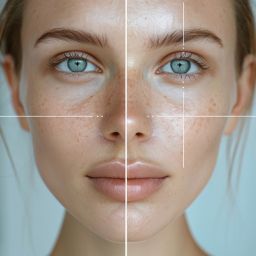From a Nurse Practitioner with Medical Dermatology Experience
Thinking about Botox or fillers? One thing that makes a big difference—but doesn’t get talked about enough—is facial anatomy. Knowing exactly where muscles, vessels, and nerves are located helps your provider place product safely and effectively. It’s what leads to smooth, natural-looking results and helps avoid complications. So when it comes to injectables, training and anatomy knowledge truly matter.
As a Nurse Practitioner with advanced training in aesthetics and a background in medical dermatology, I’ve learned that successful injectable treatments rely just as much on science as they do on artistry. Understanding what lies beneath the skin is what helps us achieve natural, balanced, and safe outcomes.
What Lies Beneath: The Layers Involved in Facial Injections
When we perform injections like Botox or fillers, we aren’t just working on the surface—we’re navigating a complex structure that includes:
- Muscles
- Nerves
- Blood vessels
- Fat pads
- Bone
Each of these layers plays a role in how your face looks, moves, and ages. Every face is different—so safe, effective injection techniques require a personalized, anatomy-aware approach.
The Risks of Neglecting Facial Anatomy in Aesthetic Treatments
Injections are often marketed as quick and easy, many patients don’t realize the risks when facial anatomy isn’t respected. These can include:
- Vascular occlusion (when filler accidentally enters a blood vessel)
- Nerve damage
- Facial asymmetry
- Tissue necrosis
- Unnatural expressions
Unfortunately, complications like these tend to happen when injectors lack the appropriate anatomical training or medical background. This is why choosing a credentialed, experienced provider is so important.
With a clinical background in medical dermatology, I bring a unique level of insight to aesthetic care. Not only do I understand the deeper structures of the face, but I also assess the health of the skin itself. That includes recognizing and managing underlying conditions like rosacea, acne, eczema, or skin sensitivity that could affect the outcome of injectable treatments.
In dermatology, we’re trained to look at the big picture: skin layers, healing time, inflammation, and how the skin responds to everything from trauma to product ingredients. I carry that mindset into every aesthetic procedure I perform.
How to Choose a Qualified, Anatomy-Savvy Injector
Here’s what you can do to ensure you’re in safe hands:
- Ask about your provider’s credentials. Choose a licensed medical professional like a Nurse Practitioner, RN, PA, or MD.
- Make sure they understand anatomy. Ask where they received their training and whether it included cadaver labs or anatomy-focused education.
- Watch how they assess your face. A qualified injector will examine your unique structure and movement—not just offer a one-size-fits-all plan.
- Choose someone who also understands skin. Providers with dermatology backgrounds bring a more complete view of both form and function.
Beauty Backed by Science: Why Anatomy and Experience Matter
Injectables are medical treatments—not just beauty services. And while they can offer incredible, confidence-boosting results, the foundation must be built on safety, knowledge, and anatomy. When you’re ready for safe, confident injectable treatments, I’m here to help!
Ready to take the next step?
Learn more about our expert medical staff, explore our full range of injectable treatments, and schedule your personalized consultation to begin your journey toward refreshed, natural-looking results.
Sources
- Pessa, J. E., & Rohrich, R. J. (2007). Facial topography: Clinical anatomy of the face. Plastic and Reconstructive Surgery, 120(7), 145S–157S. https://doi.org/10.1097/01.prs.0000264445.17458.f9
- Beleznay, K., Carruthers, J. D., Humphrey, S., & Carruthers, A. (2014). Avoiding and treating blindness from fillers: A review of the world literature. Dermatologic Surgery, 40(6), 713–725. https://doi.org/10.1097/DSS.0000000000000062
- Snozzi, P., & van Loghem, J. A. (2018). Complication Management Following Soft Tissue Filler Injections. Clinical, Cosmetic and Investigational Dermatology, 11, 295–302. https://doi.org/10.2147/CCID.S177227
- Goldberg, D. J. (2010). Cosmetic Dermatology: Procedures and Techniques. Wiley-Blackwell.



